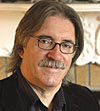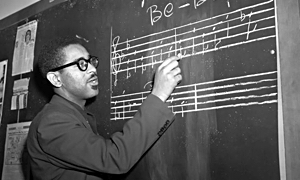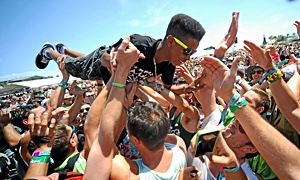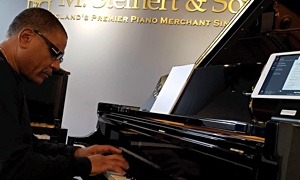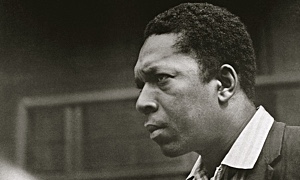Home » Jazz Articles » Jazz Primer » Miles Davis: Unlimited Miles
Miles Davis: Unlimited Miles
For music, style, language and business, Davis was at the top of the game. One to never step aside and let critics dissuade or impede his aspirations, he constantly retooled his band with the brightest most gifted young players of the moment. There are those who will argue that Charlie Parker, Louis Armstrong, Dizzy Gillespie, John Coltrane, Oscar Peterson were equals. But while these artists contributed mightily, Davis took note of what was happening outside the idiom and adapted his music to the world around him. He saw a useful role for electronics. He understood the potential of world rhythms. And he didn't react like a dilettante to other musical genres. Instead, he embraced rhythm and blues, reggae, funk and hip hop, enhancing the flavor of his own music.
The first live jazz concert I witnessed was a somber evening with the Modern Jazz Quartet in 1962. By all accounts it should have been my last. I'd been listening in earnest to Miles Davis' Kind Of Blue sinking deeper and deeper into the various nuances and complexities of the music. With each spin came new revelations. Yet there I was, sitting like a prisoner at my first live jazz concert listening to the Modern Jazz Quartet playing a dry sophisticated style of jazz that felt like someone reading from the Yellow Pages. There was no swaggering, no highs or lows—just all the right notes correctly positioned. I wondered if all jazz was as placid as this.
A few months passed, and then Miles came to town (Louisville, Kentucky). Along with him were bassist Paul Chambers, drummer Jimmy Cobb, saxophonist George Coleman and pianist Wynton Kelly. Here was something to get worked up about. I'd been trying desperately to figure out the shifting sequence of chords over the pedal point at the beginning of "Someday My Prince Will Come." Pianist Wynton Kelly was playing voicings I'd only heard Bill Evans structure. The intro seemed as if it covered the same distance as a normal solo. Kelly kept elevating the tension with each modified harmony. The right hand danced about lyrically, punctuating each tonal shift before segueing into Miles' muted trumpet. The effect was breathtaking. From that moment it was a play for the heart. The rest of the evening spun through an array of Mile's collectibles—"So What," "Green Dolphin Street," "Joshua," "All Blues," and on.
A year or so later Miles returned with an even more delectable unit, this one propelled by drummer Tony Williams. This concert was a sonic blast. People nearby commented on the seemingly radical personnel change and heated interplay. Even tunes like "My Funny Valentine," had a new-found tension. Herbie Hancock's keyboard harmonies were darkly dissonant textures that provided Davis with greater options. As the final cymbal crash faded you could sense a feeling of both relief and contentment.
Every band I worked with over the following decade—whether rock, country, pop, rhythm and blues, hippie tie-died, or whatever—the players packed copies of Miles Davis' most recent recording. When Davis hit with Miles in the Sky in 1968, the transformation was underway. Drummer Williams began spinning hard rock rhythms, something unheard of in jazz circles. The next few recordings, In A Silent Way and Bitches Brew would permanently alter the course of jazz, opening the gates to more experimental units like Michael White's Fourth Way, and others. Like nomads in a desert caravan we waited until our point man signaled us forward.
Miles arrived at the now defunct Colonial Tavern in Toronto during the early seventies with a new band and a new sound: Jack DeJohnette, Chick Corea, Miroslav Vitous and company. The band played fierce, unrelenting fusion as Davis looked on from off-stage. Towards the set's conclusion Miles came forward, blew a few notes and retreated. All in a days work.
Miles never retreated musically. Star People, Decoy, Your Under Arrest, Amandla, Doo Bop, brought new faces and new sounds. During live performances, Davis began to sink into the background, giving players like John Scofield and Kenny Garrett greater latitude.
The last Davis concert I witnessed was in Toronto at Roy Thomson Hall. Scofield, Robert Irving III, Rodney Jones, Bob Berg and a percussionist whose name I can't recall were present. Davis, dressed in Zorro black attire, tucked himself in a crevice between the main stage speaker cabinets and the stage curtains. He'd occasionally bounce a few select notes from amplified trumpet into the brick wall. Most the evening he stayed buried in the shadows.
Near the end of the set Miles arrived center stage to an outpouring of crowd adulation. The band continued pumping a mesmerizing back beat interrupted at odd intervals by Irving's synthesizer. Davis was on the prowl. First, he replaced Irving behind the synthesizer for a few stabs at the keyboard. Then he crossed in front of the band. He belched a few notes, paused, and then looked at Berg. Berg received the eye contact as a cue to solo. As soon as Berg unleashed a sheaf of notes Davis placed a forearm on his mid-section, silencing the horn. It wasn't a hard chop but rather, notice to remain in position until otherwise notified.
As if that move wasn't strange enough, Davis then proceeded to lounge around the percussionist. The fellow sported a broad smile. Davis looked on approvingly then extended a hand in "low-five" position. The player kept smiling. Davis didn't flinch. Once again he leveled the hand in front of the man. This time the guy accepted the bait. As the fellow slapped Mile's palm, Davis grabbed and locked it in, leaving him to play one-handed. The one hand solo went on an eternity until Davis decided to release it. The scene was weird, but for Davis, nothing out of the ordinary.
Miles Davis' music is just as popular in 2009 as it was forty years ago. With all of the advancements and innovations he brought to the idiom not much has changed since his departure. For the moment the Neo-cons rule.
How would Miles view the current state of jazz? I don't think he'd be too approving. Gone are the "techno" experiments he forged with Marcus Miller, back are the post-bebop days of the early sixties. But then again, he may have warmed to the adventuresome duo of Dave Douglas and Joe Lovano. With him, anything was possible.
< Previous
The Abstract Truth
Next >
Not By Chance
Comments
Tags
Miles Davis
Jazz Primer
Bill King
United States
Charlie Parker
Louis Armstrong
Dizzy Gillespie
John Coltrane
oscar peterson
Modern Jazz Quartet
Paul Chambers
Jimmy Cobb
George Coleman
Wynton Kelly
Bill Evans
Tony Williams
Herbie Hancock
Jack DeJohnette
Chick Corea
Miroslav Vitous
John Scofield
Kenny Garrett
Robert Irving
Rodney Jones
Bob Berg
Marcus Miller
Dave Douglas
joe lovano
For the Love of Jazz
 All About Jazz has been a pillar of jazz since 1995, championing it as an art form and, more importantly, supporting the musicians who create it. Our enduring commitment has made "AAJ" one of the most culturally important websites of its kind, read by hundreds of thousands of fans, musicians and industry figures every month.
All About Jazz has been a pillar of jazz since 1995, championing it as an art form and, more importantly, supporting the musicians who create it. Our enduring commitment has made "AAJ" one of the most culturally important websites of its kind, read by hundreds of thousands of fans, musicians and industry figures every month.
